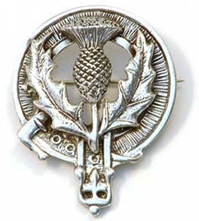|
Loudoun
(Scottish Gaelic:
Lughdan) is an area of East
Ayrshire, Scotland, east of Kilmarnock. The word
Loudoun is derivative of the Celtic Pagan God
name Lugus. It is a parish and is named after
the former village which stood north of Galston.
The area is commonly referred to as the "Irvine
Valley", for the River Irvine which flows
through it. Loudoun Kirk, the burial place of
the Campbells of Loudoun is nearby. The village
has vanished, however plans to rebuild the lost
village are under consideration by the council.
Brae is the Lowland Scots word for the
slope or brow of a hill.
Loudoun's
most prominent geographical feature is Loudoun
Hill, site of several minor battles during
Scotland's history. The area of Loudoun is also
home to the famous Loudoun Castle (shown
above).
The shell
you see today is of a building created in the
early 1800s by Flora Mure-Campbell, Countess of
Loudoun in her own right and through marriage
Marchioness of Hastings. There were earlier
structures on the site of the present castle
which itself replaced another castle half a mile
to the east - Arclowdun - reputedly sacked by
the Kennedys of Culzean in a raid in medieval
times. In its heyday, the Castle was known as
the ‘Windsor of Scotland’
The
earliest part of the building incorporated in
the present ruins is thought to have been a four
storey keep, probably built by the Craufurds of
Loudoun in the 1400s. This keep was some 30 feet
by 20 feet with walls at least six feet thick
and its foundations lie deep and inaccessible in
the present ruins.
The First
Earl of Loudoun, Sir John Campbell, Chancellor
of Scotland, erected additional buildings to the
south of the old keep which were also
incorporated in the later rebuilding. It is
thought that this work was carried out about the
time of the creation of the Earldom of Loudoun
in 1601.
One
estimate suggests that the "improvements" to
Loudoun Castle between 1804 and 1811 cost over
£100,000 - over £3,500,000 in today's money.
It is
considered that James and Robert Adam and
particularly Archibald Elliot were influential
in the architectural work. The massive
structure, known as The Windsor of Scotland, had
over 90 apartments and was dominated by the main
tower of which now, one solitary corner remains
dramatically in place as an eerie monument to
its builders. History has it that drafts of the
Treaty of Union of 1707 were discussed under the
Auld Yew Tree in the gardens.
On the
night of the fire, 1st December 1941, the family
comprising the Countess Edith, her daughters and
infant granddaughter Sheena, were sleeping in
their rooms under the first floor library.
Heating was by coal and log fires and it is
thought that burning resin came back down the
library chimney setting the wooden floor alight.
The family
awoke to the frightening sound of the raging
fire above them, fled to what is now the Estate
House, and since that day no other member of the
family has slept in the Castle.
Like all
self-respecting castles of antiquity, Loudoun
castle has its ghosts. The best known is the
Grey Lady who flitted about the castle with such
regularity that she was accepted as part of the
fittings and did not disturb the smooth running
of the castle.
There is
also the Phantom Piper and the Benevolent Monk
who seems to wander the policies wishing anyone
who comes within earshot 'Pax Vobiscum' (Peace
be with you).
The castle
and grounds are now a theme park. |



